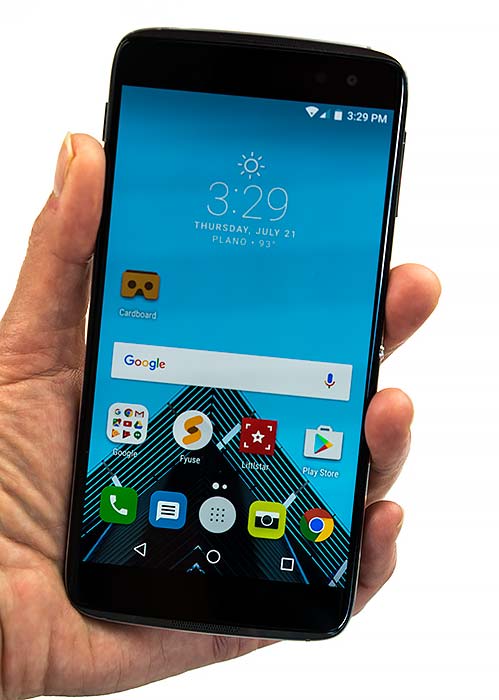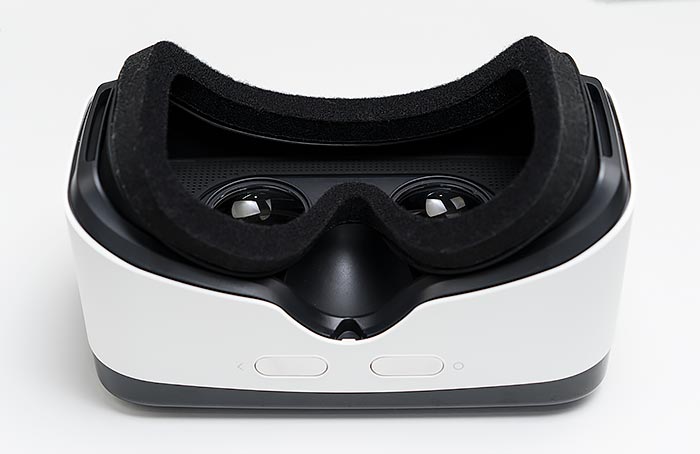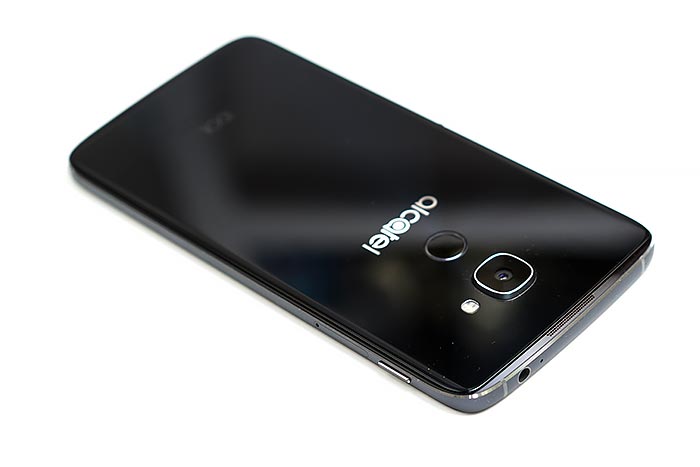|
Alcatel impressed us last year with the OneTouch Idol 3, an affordable Android smartphone that didn't look in the least bit cheap and had fairly good performance for the price. The Idol 4S is the company's first attempt at a high end phone, though the price is relatively tame at $399 ($350 introductory pricing for pre-orders before the August 3, 2016 ship date). For the price you get pretty impressive specs except the very solid but still midrange 1.8 GHz Snapdragon 652 CPU. The phone has 3 gigs of RAM, 32 gigs of storage, a microSD card slot compatible with cards up to 200 gigs, a fingerprint scanner, high resolution cameras and a very bright AMOLED QHD 2560 x 1440 display. It has LTE 4G on AT&T, T-Mobile, their smaller offshoot carrier brands and many regional carriers. It's unlocked and has two SIM card slots (you can only use one if you also wish to use a microSD card). Sounds pretty sweet, right? At least as long as you're not craving the fastest possible CPU like the Snapdragon 820 found in much more expensive phones like the US Samsung Galaxy S7, HTC 10 and the similarly priced OnePlus 3. But wait, there's more--a companion VR headset is included in the box. In fact, the phone ships mounted safely inside the white plastic VR headset. Interesting, isn't it?
Don't confuse the Idol 4S with the $199 Idol 4 available on Cricket Wireless. The missing "S" means a lower resolution display, smaller battery, half the storage and a 13MP rather than 16MP rear camera. But you do get that VR headset, so the Idol 4 isn't a bad deal. But back to the Idol 4S, if you're excited by VR it could be a tantalizing phone for the price. But if you're not so keen on VR, is the headset enough to convince you to buy the Idol 4S rather than the enthusiast oriented OnePlus 3 or the solid budget Moto 4G that's just $199?
Unlocked GSM Phone
The Alcatel Idol 4 is an unlocked GSM phone, so it's not compatible with Sprint and Verizon that use CDMA rather than GSM. This model is designed for the US, so it will work on T-Mobile and AT&T in the US, and you'll get voice and 2G data overseas. It has two SIM card slots, a feature that's more popular overseas than in the US, and that means you can use two AT&T or two T-Mobile SIM cards, or a T-Mobile and a Cricket SIM in the phone at once (or most any other GSM carrier's SIM).

Design and Ergonomics
This is a seriously slim and very good looking phone that doesn't fall far short of more expensive phones in terms of style and materials. It's glass front and back, and ours has a very dark blue-black glass back. It bears a striking, if not embarrassing resemblance to the Samsung Galaxy S6, and the "Boom" key on the side looks like the Sony Xperia camera button. Derivative design aside, this 7mm, 5.25 ounce smartphone looks more expensive than you might expect for the price. The highly polished metal bevels are a nice touch on the sides, and they create contrast with the matte gray sandwiched in between--it's a nice refinement of the Idol 3 design. The Boom button is contextual, which means it does different things depending on the app you're in, but the default home screen action is to take a photo even if the screen is off. It's handy as a shutter button when in the camera app, but otherwise I didn't find it all that useful. It also wakes the phone up, which is useful because the power button is on the left (I hear that right handed folks don't like that, but as a lefty it's OK with me). The volume controls are on the right, the headphone jack is up top and the micro USB port is offset on the bottom.
Sound from the 3.6 watt stereo speakers is impressively loud and full--Alcatel knows how to do speakers. They face front (top and bottom) as well as back, so you'll get plenty of sound in both directions. Waves MaxxAudio (more commonly found on Windows PCs than phones) lets you choose from different sound presets and tweak EQ, though we found factory settings good for a variety of uses.
Display
The 5.5" AMOLED 2560 x 1440 is very competitive with today's most expensive phones. It's one way that the Idol 4S trumps the OnePlus 3's 1080p display. This is a very bright display that's visible outdoors and colors and contrast are extremely high, which is typical of AMOLED. Colors are very zingy but not exactly natural because of a very cool native white point.
Idol 4S VR Goggles
Though the Idol 4S VR Goggles might look an awful lot like the Samsung Gear VR goggles, the experience and viewing quality aren't even close to what Samsung and Oculus offer for the Galaxy line. The beefy white plastic goggles have a set of lenses that the phone's display faces. Like the Gear VR, the phone is held in place by plastic clamps that do the job fine, and you snap on a sunglass-like plastic cover to block out stray light. Unlike the Gear VR, there's no USB connection to the phone, so that means no fancy d-pad or controller mounted on the headset. The Idol goggles have an opening for the phone's headphone jack (passably OK JBL earbuds are included), and two overly sensitive touch buttons on the underside that use magnets to trigger the phone to respond. These function as select and back buttons. Sometimes they don't work the first time, and I've often managed to brush them accidentally and back out of a game or video mid-stream.

What these really are is a classier counterpart to Google Cardboard. And for that, it does fine--you get a cushy foam padded rim to avoid forehead rash, a detachable head strap and something that won't dissolve in the rain. View-Master, the company that made those stereoscopic slide viewers for kids (if you're old enough to remember), is making something similar for $30. Like the Samsung Galaxy S7, the Alcatel gets hot when in the goggles since the phone is working very hard and is sitting in an enclosed space.
There's no focus adjustment, but I generally found everything to be in focus despite my astigmatism, nearsightedness and presbyopia. Things look very up-close compared to Gear VR and the HTC Vive, and maybe that helps with perceived focus. VR Videos and photos look low resolution and grainy. I never got motion sickness because the experience wasn't real enough to fool my brain into thinking it was looking at a real environment. Content is provided by Littlestar, and there's not much of it. Of course you can download and use anything made for Google Cardboard, and the Cardboard Camera app is perhaps the most fun (you can create your own VR photos and video). The Idol 4S VR phone and goggles are unfortunately not compatible with the next generation Google Daydream virtual reality platform that will be live in the fall of 2016.

|
Deals and Shopping:
Advertisement
|

